The hidden meanings of Destined to be Happy exhibition - The Interview with Irina Korina
10 January 2017 | By
09 January 2017 | By
Inside the Picture: Installation Art in Three Acts - by Jane A. Sharp
19 November 2016 | By
Conversations with Andrei Monastyrski - by Sabine Hänsgen
17 November 2016 | By
Thinking Pictures | Introduction - by Jane A. Sharp
15 November 2016 | By
31 October 2016 | By
Tatlin and his objects - by James McLean
02 August 2016 | By
Housing, interior design and the Soviet woman during the Khrushchev era - by Jemimah Hudson
02 August 2016 | By
Dressing the Soviet Woman Part 3: "Are Russians Women?" Vogue on Soviet Vanity - by Waleria Dorogova
18 May 2016 | By
Dressing the Soviet Woman Part 1 - by Waleria Dorogova
13 May 2016 | By
Eisenstein's Circle: Interview With Artist Alisa Oleva
31 March 2016 | By
Mescherin and his Elektronik Orchestra - by James McLean
13 January 2016 | By
SSEES Centenary Film Festival Opening Night - A review by Georgina Saunders
27 October 2015 | By
Nijinsky's Jeux by Olivia Bašić
28 July 2015 | By
Learning the theremin by Ortino
06 July 2015 | By
Impressions of Post- Soviet Warsaw by Harriet Halsey
05 May 2015 | By
Facing the Monument: Facing the Future
11 March 2015 | By Bazarov
'Bolt' and the problem of Soviet ballet, 1931
16 February 2015 | By Ivan Sollertinsky
Some Thoughts on the Ballets Russes Abroad
16 December 2014 | By Isabel Stockholm
Last Orders for the Grand Duchy
11 December 2014 | By Bazarov
Rozanova and Malevich – Racing Towards Abstraction?
15 October 2014 | By Mollie Arbuthnot
Cold War Curios: Chasing Down Classics of Soviet Design
25 September 2014 | By
Walter Spies, Moscow 1895 – Indonesia 1942
13 August 2014 | By Bazarov
'Lenin is a Mushroom' and Other Spoofs from the Late Soviet Era
07 August 2014 | By Eugenia Ellanskaya
From Canvas to Fabric: Liubov Popova and Sonia Delaunay
29 July 2014 | By Alex Chiriac
My Communist Childhood: Growing up in Soviet Romania
21 July 2014 | By Alex Chiriac
Monumental Misconceptions: The Artist as Liberator of Forgotten Art
12 May 2014 | By Rachel Hajek
28 April 2014 | By Rachel Hajek
An Orgy Becomes a Brawl: Chagall's Illustrations for Gogol's Dead Souls
14 April 2014 | By Josephine Roulet
KINO/FILM | Stone Lithography Demonstration at the London Print Studio
08 April 2014 | By Alex Chiriac
24 March 2014 | By Renée-Claude Landry
Book review | A Mysterious Accord: 65 Maximiliana, or the Illegal Practice of Astronomy
19 March 2014 | By Rosie Rockel
Leading Ladies: Laura Knight and the Ballets Russes
10 March 2014 | By Bazarov
Exhibition Review | Cash flow: The Russian Pavilion at the 2013 Venice Biennale
03 March 2014 | By Rosie Rockel
24 February 2014 | By Ellie Pavey
Guest Blog | Pulsating Crystals
17 February 2014 | By Robert Chandler Chandler
Theatre Review | Portrait as Presence in Fortune’s Fool (1848) by Ivan Turgenev
10 February 2014 | By Bazarov
03 February 2014 | By Paul Rennie
Amazons in Australia – Unravelling Space and Place Down-Under
27 January 2014 | By Bazarov
Exhibition Review | Siberia and the East, fire and ice. A synthesis of the indigenous and the exotic
11 December 2013 | By Nina Lobanov-Rostovsky
Shostakovich: A Russian Composer?
05 December 2013 | By Bazarov
Marianne von Werefkin: Western Art – Russian Soul
05 November 2013 | By Bazarov
Chagall Self-portraits at the Musée Chagall, Nice/St Paul-de-Vence
28 September 2013 | By Bazarov
31 July 2013 | By Richard Barling
Exhibition review | Lissitsky — Kabakov: Utopia and Reality
25 April 2013 | By Richard Barling
Exhibition review | Ilya and Emilia Kabakov: The Happiest Man
18 April 2013 | By Richard Barling
27 January 2014 | By Bazarov
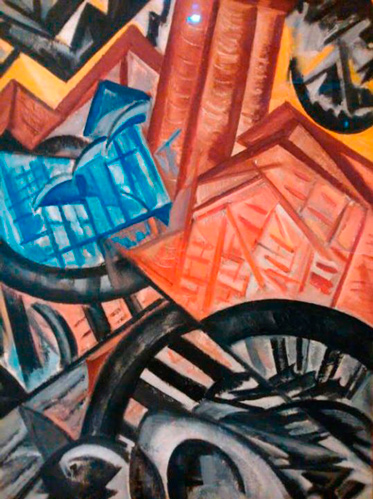
On a single floor in the Art Gallery of Western Australia I visited two exhibitions which, together, offered an object-lesson in the dismantling of space on the picture plane. It was the extraordinary and unanticipated consequence of placing an eye-watering array of modernist pictures on loan from MoMA alongside the Western Australian Indigenous Art Awards, 2013.
Both shows dealt overwhelmingly with the depiction of space and place, from Cezanne and the Fauves and Futurists in one gallery to the remembered patterns of an ancestral landscape in the other.In fact the MoMA show fast-forwarded to pop and photorealism, and the Indigenous Art veered from transcribed land art to soft sculpture and images of cultural alienation. For followers of GRAD I will focus on just four works, two from each show.
The Amazons of the Russian Avant-Garde, so named by writer and critic Benedikt Livshits in 1933, were represented by two highly characteristic works from MoMA. Olga Rozanova's The Factory and the Bridge (1913) shows a disassembled but still recognisable city, chimneys and bridges separated by hard-to-read and clashing passages in blue and orange and yellow. The clangour of the modern city is there before our dazed eyes, but there is no secure vantage point from which to view it. We wheel and turn with the painting.
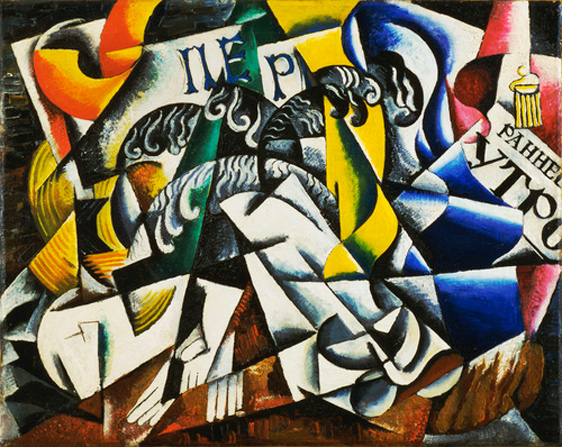
Subject from a Dyer's Shop, Liubov Popova, 1914
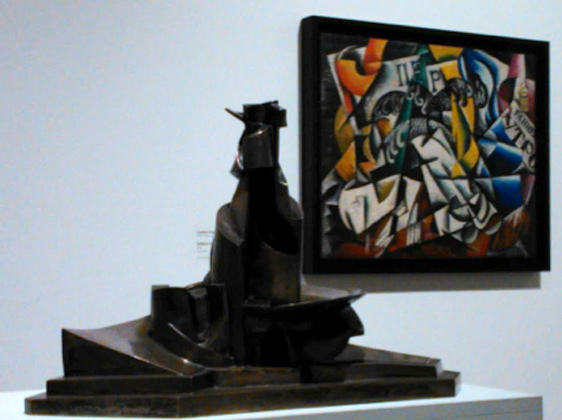
Development of a Bottle in Space, Umberto Boccioni, 1912
Subject from a Dyer's Shop by Liubov Popova (1914) is revealingly displayed alongside Umberto Boccioni's shape-shifting futurist sculpture Development of a Bottle in Space (1912). In both works the interior world is subjected to an equivalent act of dis-assembly, the familiar is 'made strange' (in the terminology of Russian Formalism of the time), and through strangeness becomes newly immediate, intimate, engaging. Popova's colours and visual references are of the material world, but the forms are not. Fabrics and frills and text fragments are as they might be in a tumble-dryer, and our eye is tossed about accordingly.
Moving from modernist, materialist Russia to the art of aboriginal Australia might seem a stretch, but the correspondences to me are revealing. Artists Minyawe Miller (Untitled, 2012) and Churchill (Yoonany) Cann (Doogoorreninyem, 2012) have used media ranging from polymer paint to natural pigments to translate onto canvas their personal and accumulated understanding of the landscape which over forty millennia offered their peoples home, sustenance, and a structure for their beliefs.
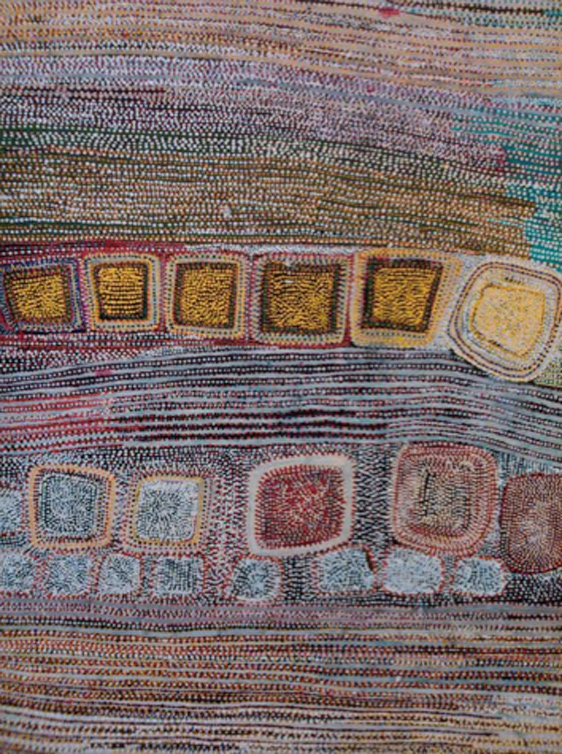
Minyaw Miller, Untitled, 2012
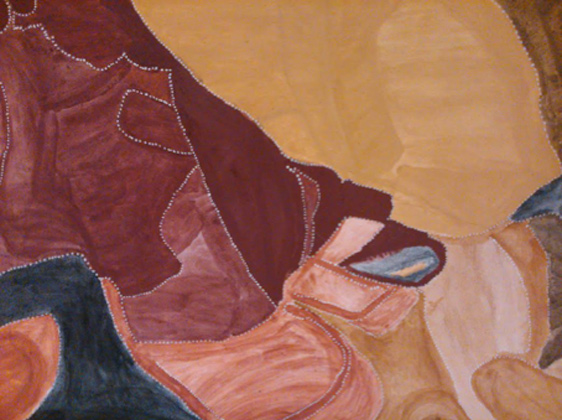
Churchill (Yoonany) Cann, Doogooreninyem, 2012
The results are apparent abstractions which nevertheless carry powerful meaning to those who can read them, and offer a stillness, a reduction from the turbulence of the European city to the quiet of the Australian desert, from noise to silence. As with the Russian artists, however, colour and form do the work of making strange, only to clarify with prolonged viewing. Miller has walked this country, and seems to have internalised the landmarks and waterholes, bringing them back to us in brilliant skeins and whorls of color.
Cann speaks of his earth-coloured, map-like patterns: 'I'm doing them hill when we bin travelling. I'm thinking about what them hills really look like. I just follow them hills when I bin walk.' The language is certainly not that of Charles Baudelaire’s flaneur, but I think we find here the attention to 'gait, glance and gesture' that Baudelaire was advocating in his essay 'The Painter of Modern Life' (1863). These indigenous paintings are works of today, modern for the artists who made them, unravelling and in so doing explaining and sharing the landscape as they knew it.
So did those more familiar Amazons who made such a welcome visit to Australia.


